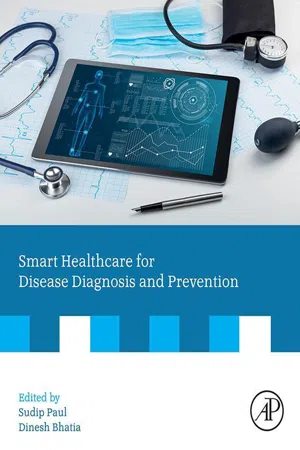
- 270 pages
- English
- ePUB (mobile friendly)
- Available on iOS & Android
Smart Healthcare for Disease Diagnosis and Prevention
About This Book
Smart Healthcare for Disease Diagnosis and Prevention focuses on the advancement in healthcare technology to improve human health at all levels using smart technologies. It covers all necessary topics from basic concepts (such as signal and image processing) to advanced knowledge on topics such as tissue engineering, virtual and intelligent instrumentation (or VLSI) and Embedded Systems. This book can be used to guide students and young researchers, providing basic knowledge on signal/image processing and smart technologies. Users will find a perfect blend of the interdisciplinary approach to biomedical engineering.
The book considers many technical concepts, emerging technologies, real-world healthcare applications, and many other technical, multidisciplinary notions in the same content. Finally, it systemically introduces the technologies and devices for healthcare objects and targets disease diagnosis and prevention in different views.
- Discusses how new advanced technologies are used in real healthcare applications to improve patient safety
- Explores how medical data such as signals and images can be used in diagnosis
- Covers how wireless communications devices, such as sensor networks, RFID, wireless body area network, and wearable sensors are used in the medical environment
Frequently asked questions
Information
A very short story for a new future
Abstract
Keywords
1.1 Introduction
1.2 Methodology



1.3 Results
- – Android 4.4.4 Kit Kat
- – 1 GB Ram
- – 1.1 GHz Processor
- – 40 MB free space
1.4 Discuss and conclusion
Table of contents
- Cover image
- Title page
- Table of Contents
- Copyright
- List of contributors
- Preface
- Acknowledgment
- Chapter 1. A very short story for a new future
- Chapter 2. Design and development of command prompt assist device for locked in syndrome patients
- Chapter 3. Stem cell factor induces mast cell degranulation and proliferation independent of CD81 receptor
- Chapter 4. Triply periodic minimal surface porous implants to reconstruct bone defects
- Chapter 5. Preparation and characterization of gold nanoparticles conjugated insulin
- Chapter 6. Application of machine learning for early diagnosis of Parkinson’s disease
- Chapter 7. Power spectrum analysis of heart rate variability during internally and externally operative attention
- Chapter 8. Investigation of heart rate variability with the help of Welch periodogram in Indian young adults based on body physique
- Chapter 9. An insight into Parkinson’s disease: researches and its complexities
- Chapter 10. Investigation into the occupational ride comfort due to exposure of whole body vibration
- Chapter 11. Fuzzy entropy based seizure detection algorithms for EEG data analysis
- Chapter 12. Low-cost ultrasonic-based shoe for visually impaired people
- Chapter 13. Design of array multiplier circuit using reversible logic approach with optimized performance parameters
- Chapter 14. Smart diagnosis of cardiac arrhythmias using optimal feature rank score algorithm for solar based energy storage ECG acquisition system
- Chapter 15. Therapeutic approach in cerebral palsy treatment and management: outcomes and benefits
- Chapter 16. Magnetic nanoparticles mediated cancer hyperthermia
- Chapter 17. Bone cancer detection using machine learning techniques
- Chapter 18. Introduction to physiology
- Chapter 19. Basic overview of human physiology
- Chapter 20. Smart healthcare with sensors and wireless body area networking
- Chapter 21. Muscular load compensation patterns in patients with knee osteo-arthritis
- Index